|
Preparing to Exercise
No matter at what age you begin to exercise,
or how long you may have been inactive, proper exercise will
always improve your physical condition. The exercises in this
booklet can be done by people who have been inactive for some
time. Programs to improve flexibility, strength, and endurance
are arranged in three levels of difficulty. It is important
to begin any exercise program slowly and build up gradually.
Remember, it may take several months to attain the minimal levels
of physical fitness identified in Level I activities. Some people
will take less time, others more.
Before beginning an exercise program, have a
physical examination and discuss the program with your doctor.
In addition, if your mobility is limited as a result of a chronic
or disabling condition, be sure to review these exercises with
your doctor. Keep in mind your level of ability and endurance
so that you don't risk discomfort or injury. If you experience
pain while exercising, stop that particular movement and ask
your doctor about it on your next visit.
Stick with it, and you will see results!
Warming Up
Preparing the body for exercise is important
for people at any age and all fitness levels. A warm-up period
should begin with slow, rhythmic activities such as walking
or jogging in place.
Gradually increase the intensity until your
pulse rate, respiration rate and body temperature are elevated,
which is usually about the time that you break a light sweat.
It also is advisable to do some easy stretching exercises (such
as the ones on page 6) before moving on to the strength and
endurance activities.
Effective Exercising
Once you begin your daily exercise routine,
keep these points in mind to get the best results:
- Always drink water before, during and after
your exercise session.
- Make exercising a part of your daily routine.
You may want to set a regular time to exercise each day and
invite a friend to join you.
- Start gradually, about 5 to 10 minutes at
first.
- Increase the amount of exercise each day,
up to about 30 to 60 minutes.
- Breathe deeply and evenly during and between
exercises. Don't hold your breath.
- Rest whenever it is necessary.
- Keep a daily written record of your progress.
- Exercise to lively music, TV, or with friends
for added enjoyment.
Cool Down
If you have been participating in vigorous physical
activity, it is extremely important not to stop suddenly. Abrupt
stopping interferes with the retum of the blood to the heart
and may result in dizziness or fainting. Simply reduce the intensity
of the exercise gradually and end with a few slow stretches
from the section on stretching.
Exercising from a Wheelchair
A number of the exercises in this booklet can
be performed from a chair or a wheelchair. They are identified
with the symbol: (o)
Flexibility
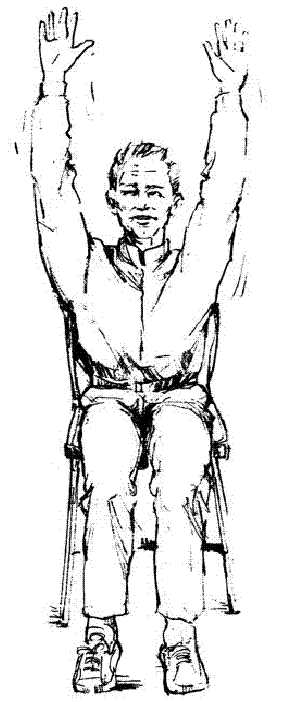 Exercises in this category
will help you maintain your range of motion. Through the normal
aging process, muscles tend to lose elasticity and tissues around
the joints thicken. Exercise can delay this process by stretching
muscles to prevent them from becoming short and tight. It also
helps slow down the development of arthritis, one of the most
common and painful diseases associated with advancing age. Exercises in this category
will help you maintain your range of motion. Through the normal
aging process, muscles tend to lose elasticity and tissues around
the joints thicken. Exercise can delay this process by stretching
muscles to prevent them from becoming short and tight. It also
helps slow down the development of arthritis, one of the most
common and painful diseases associated with advancing age.
In addition to performing flexibility exercises,
you should try to bend, move, and stretch every day to keep
joints Flexible and muscles elastic. Avoid reliance on push
buttons and conveniences that take away the need for personal
motion. And, compliment this program with such recreational
activities as dancing, yoga, swimming golfing, gardening, and
housework.
Be sure to begin each workout with deep breathing
and continue deep breathing at intervals through- out the session.
You should work up to a total of 50 deep breaths per workout.
Flexibility Level I

1) Finger Stretching: to maintain finger dexterity.
With the palm of the right hand facing down, gently force fingers
back toward forearm, using left hand for leverage; then place
left hand on top and push fingers down. Suggested repetitions:
5 each hand. (o)

2) Hand Rotation: to maintain wrist flexibility and
range of motion. Grasp right wrist with left hand. Keep
right palm facing down. Slowly rotate hand 5 times each clockwise
and counter-clockwise. Suggested repetitions: 5 each hand. (o)
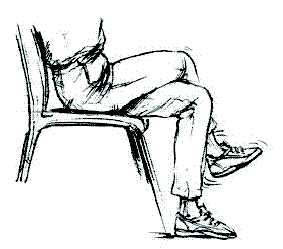
3) Ankle and Foot Circling: to improve flexibility
and range of motion of ankles. Cross right leg over opposite
knee, rotate foot slowly, making large complete circles. 10
rotations to the right, 10 to the left, each leg. (o)
4) Neck Extension: to improve flexibility
and range motion of neck. Sit up comfortably. Bend head
forward until chin touches chest. You may want to stretch forward
by simply jutting your chin out. Return to starting position
and slowly rotate head to left. Return to starting position
and slowly rotate head to right. Return to starting position.
Suggested repetitions: 5. (o)
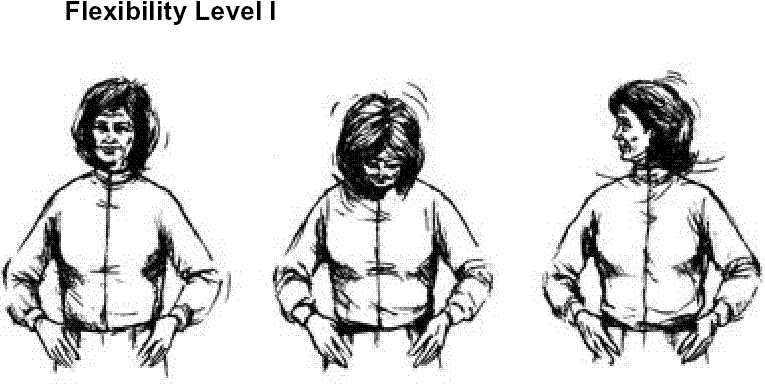
5) Single Knee Pull: to stretch lower
back and back of leg. Lie on back, hands at sides. Pull
one leg to chest, grasp with both arms and hold for five counts.
Repeat with opposite leg. Suggested repetitions: 3 – 5.
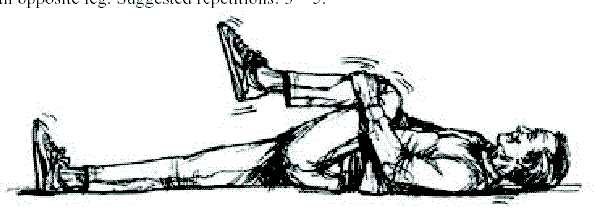
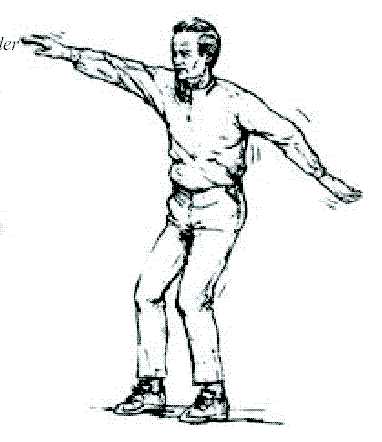 6) Simulated Crawl Stroke/Back
Stroke/Sreast Stroke: to stretch shoulder girdle.
Stand with feet shoulder- width apart, arms at sides, relaxed
Bend knees and alternately swing right and left arms backwards...upward...and
foward as if swimming. Suggested repetitions: 6 – 8 movements
on each stroke. (o) 6) Simulated Crawl Stroke/Back
Stroke/Sreast Stroke: to stretch shoulder girdle.
Stand with feet shoulder- width apart, arms at sides, relaxed
Bend knees and alternately swing right and left arms backwards...upward...and
foward as if swimming. Suggested repetitions: 6 – 8 movements
on each stroke. (o)
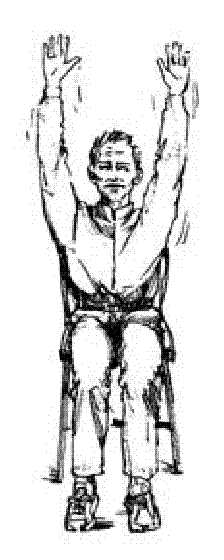
7) Reach: to stretch shoulder girdle and rib cage.
Take deep breath, extend arms overhead. If standing, rise on
toes while reaching. Exhale slowly, lowering arms, Can be done
in a seated position. Suggested repetitions: 6 – 8. (o)
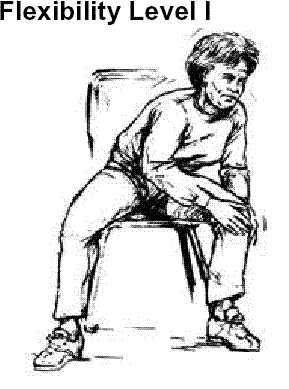
8) Backstretch: to improve the flexibility of the
lower back. Sit up straight, Bend far forward and straighten
up. Repeat, clasping hands on left knee. Repeat clasping hands
on right knee. Exhale while bending forward. Suggested repetitions:
4 – 6 over each knee. (o)
9) Chain Breaker: to stretch chest
muscles. Stand erect, feet about six inches apart. Tighten
leg muscles, tighten stomach by drawing it in, with hips forward,
extend chest, bring arms up with clenched fists chest high,
take deep breath, let it out slowly. Slowly pull arms back as
far as possible keeping elbows chest high. Suggested repetitions:
8 – 10. (o)
Flexibility: Level II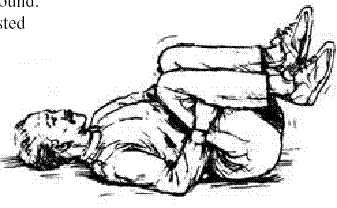
1) Double Knee Pull: to stretch lower back and buttocks.
Lie on back, hands at sides. Pull legs to chest, lock arms around
legs, pull buttocks slightly off ground. Hold for 10 to 15 counts.
Suggested repetitions: 3 – 5.
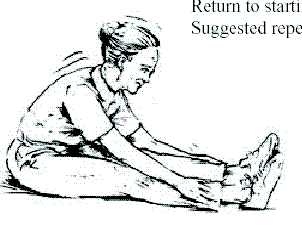 2 ) Seated Pike Stretch:
to stretch lower back and hamstrings. Sit on floor, with
legs forward, knees together. Exhale and stretch forward, slowly
sliding hands down to ankles. Stretch only as far as is comfortable
and use your hands for support. Hold for 5 to 8 counts. Don't
bounce, position inhaling deeply. repetitions: 3–4. 2 ) Seated Pike Stretch:
to stretch lower back and hamstrings. Sit on floor, with
legs forward, knees together. Exhale and stretch forward, slowly
sliding hands down to ankles. Stretch only as far as is comfortable
and use your hands for support. Hold for 5 to 8 counts. Don't
bounce, position inhaling deeply. repetitions: 3–4.
|
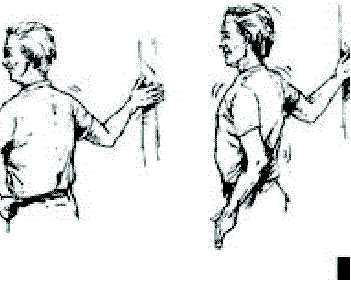
3) Chest Stretch: to stretch muscles in chest and
shoulders. Stand arm-length distant from a doorway opening.
Raise one arm shoulder height with slight bend in elbow. Place
hand against door jamb and turn upper body away so that the
muscles in chest and shoulders are stretched. Suggested repetitions:
3 – 4 each arm.
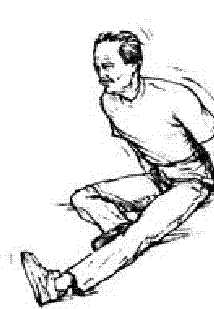
4) Seated Stretch: to stretch lower back and hamstrings.
Sit on floor one leg extended to your side and one leg bent
comfortably in front of your body. Supporting your body weight
with your hands and keeping your back straight, lean forward
until you feel a comfortable leg and hamstring. Hold the stretch
for a few seconds, exhaling. Switch sides. Suggested repetitions:
3 – 5 each side.
Flexibility Level III
1) Sitting Stretch: to increase flexibility
of lower back and hamstrings. Sit on floor with legs
extended as far apart as is comfortable. Exhale and stretch
forward slowly, sliding your hands down your legs. Reach as
far as is comfortable and hold for 5 – 8 counts. Suggested repetitions:
3-4.

2) Achilles Stretch: to stretch calf muscles on back
leg (Achilles tendon). Stand facing wall 2 to 3 feet away.
Extend arms, lean into wall. Move left leg forward 1/2 step,
right leg backward 1/2 step or more. Lower right heel to floor.
Lean hips forward, stretching the calf muscles in the right
leg. Hold 5 to 10 counts. Breathe normally. Reverse leg position
and repeat. Suggested repetitions: 3-6 each leg.
 3) Modified Seal: to
stretch abdominal wall, chest, and front of neck. Lie on
the floor with arms extended, stomach down, feet extended, with
toes pointed. While exhaling, slowly lift head and push up until
arms are bent at right angles, with back arching gently. Keep
hips on the floor. Keeping arms bent, hold for 5-10 counts,
Return to starting position, inhaling deeply. Suggested repetitions:
4-6. 3) Modified Seal: to
stretch abdominal wall, chest, and front of neck. Lie on
the floor with arms extended, stomach down, feet extended, with
toes pointed. While exhaling, slowly lift head and push up until
arms are bent at right angles, with back arching gently. Keep
hips on the floor. Keeping arms bent, hold for 5-10 counts,
Return to starting position, inhaling deeply. Suggested repetitions:
4-6.
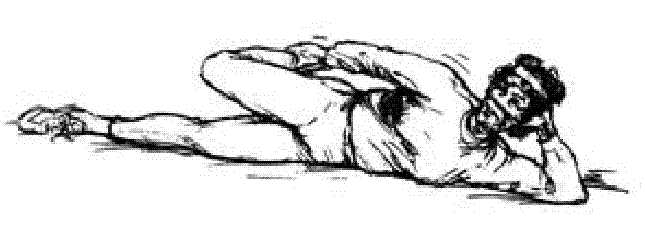 4) Half Bow: to
stretch the top of the thigh and groin area. Lie on left
side. Hold ankle of right foot with right hand just above toes.
Slightly arch back. Hold 5 to 10 counts. Suggested repetitions:
3 – 5. 4) Half Bow: to
stretch the top of the thigh and groin area. Lie on left
side. Hold ankle of right foot with right hand just above toes.
Slightly arch back. Hold 5 to 10 counts. Suggested repetitions:
3 – 5.
Strength
 Exercises designed to build strength
can help prevent premature loss of muscle tissue and can improve
muscle strength, size, and endurance at any age. The benefits
of strength exercises also include improving reaction time,
reducing the rate of muscle atrophy, increasing work capacity,
and helping prevent back problems and injury. Exercises designed to build strength
can help prevent premature loss of muscle tissue and can improve
muscle strength, size, and endurance at any age. The benefits
of strength exercises also include improving reaction time,
reducing the rate of muscle atrophy, increasing work capacity,
and helping prevent back problems and injury.
The following program of muscle conditioning
exercises for the whole body has been designed specifically
for older adults. Calisthenics work muscles against resistance,
enabling them to grow and maintain muscle tone. In addition
to the strength exercises suggested in the next section, other
physical activities that are essentially recreational can provide
benefits to help maintain muscle integrity. Such activities
include: bicycling, swimming,
Strength: Level I

1) Finger Squeeze: to strengthen the hands. Extend
arms in front at shoulder height, palms down. Squeeze fingers
slowly, then re1ease. Suggested repetitions: 5. Turn palms up,
squeeze fingers, release. Suggested repetitions: 5. Extend arms
in front, shake fingers. Suggested repetitions: 5.
2) Touch Shoulders: to increase flexibility
of the shoulders and elbows and tone the upper arm; can be done
in a seated position. Touch shoulders with hands,
extend arms out straight. Bring arms back to starting position.
Suggested repetitions: 10 – 15.
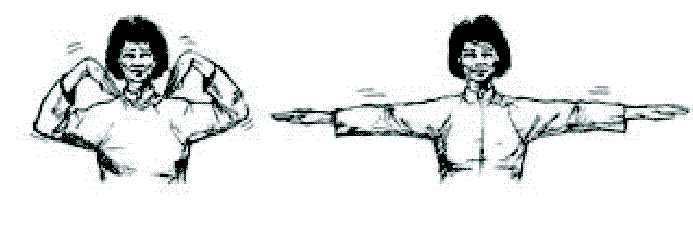

3) Leg Extensions: to tone the upper leg muscles.
Sit upright. Lift 1eft leg off the floor and extend it fully.
Lower it very slowly. Suggested repetitions: 10-15 each leg.
(o)
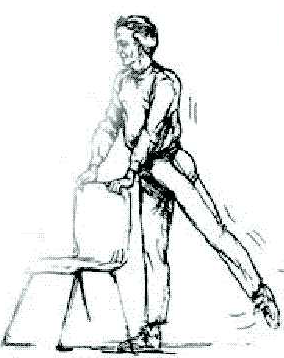 4) Back Leg Swing:
to firm the buttocks and strengthen the lower back. Stand
up, holding on to the back of a chair. Keep your back and hips
in line with the chair as you do the exercise. Extend one leg
back, foot pointed towards the floor. Keeping the knee straight,
Litt the leg backwards approximately four inches and concentrate
on squeezing the muscles in the buttocks with each lift Make
sure you keep your back straight as you raise your legs. Return
to starting position. Suggested repetitions 10 each leg. 4) Back Leg Swing:
to firm the buttocks and strengthen the lower back. Stand
up, holding on to the back of a chair. Keep your back and hips
in line with the chair as you do the exercise. Extend one leg
back, foot pointed towards the floor. Keeping the knee straight,
Litt the leg backwards approximately four inches and concentrate
on squeezing the muscles in the buttocks with each lift Make
sure you keep your back straight as you raise your legs. Return
to starting position. Suggested repetitions 10 each leg.
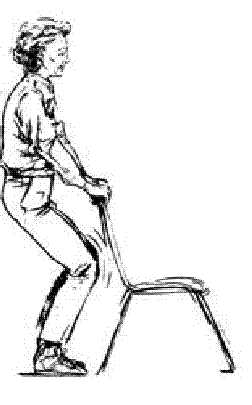
5) Quarter Squat: to tone and strengthen lower leg
muscles. Stand erect behind a chair, hands on chair back
for balance. Bend knees, then rise to an upright position. Be
careful not to let knees go beyond your toes. Suggested repetitions:
8-12.
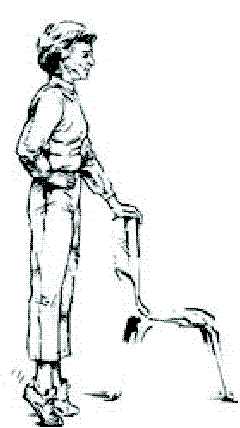
6) Heel Raises: to strengthen the calf muscles and ankles.
Stand erect, holding a chair for balance if needed, hands on
hips, feet together. Raise body on toes. Return to starting
position. Suggested repetitions: 10.
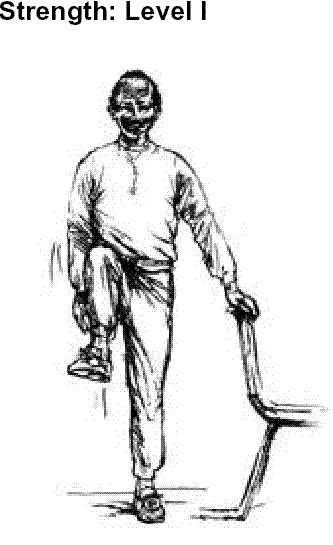
7) Knee Lift: to strengthen hip flexors and lower abdomen.
Stand erect. Raise left knee to chest or as far upward as possible
while back remains straight. Return to starting position. Repeat
with right leg. Suggested repetitions: 5 each leg.
8) Head and Shoulder Curl: to firm stomach muscles. Lie
on the floor, knees bent, arms at sides, head bent slightly
forward. Reach forward with arms extended, until finger tips
touch your knees, Hold for 5 counts. Return to starting position.
Suggested repetitions: 10.
Strength: Level II
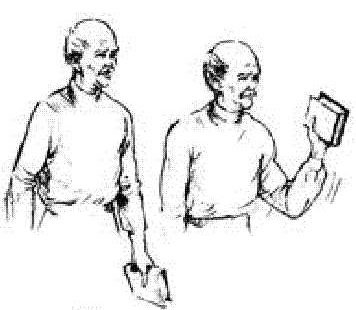 1) Arm Curl: to
strengthen arm muscles. Use a weighted object such as a
book or a can of vegetables or small dumbell. Stand or sit erect
with arms at side, holding weighted object. Bend your arm, raising
the weight. Lower it. Can be done seated. Suggested repetitions:
10-15 each arm. (o) 1) Arm Curl: to
strengthen arm muscles. Use a weighted object such as a
book or a can of vegetables or small dumbell. Stand or sit erect
with arms at side, holding weighted object. Bend your arm, raising
the weight. Lower it. Can be done seated. Suggested repetitions:
10-15 each arm. (o)
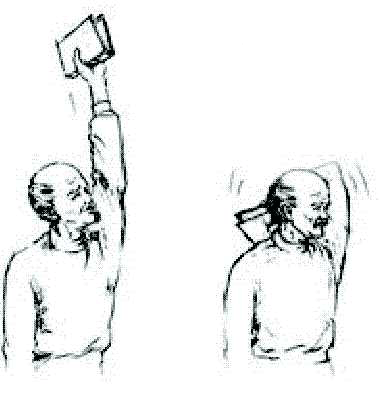
2) Arm Extension: to tone muscles in the back of the
arm. Sit or stand erect with arms at sides. Holding a weighted
object of less than 5 pounds, overhead. Slowly bend arm until
head. Slowly extend arm to The arm curl and arm extension separately
or together, alternating seated. Suggested repetitions:
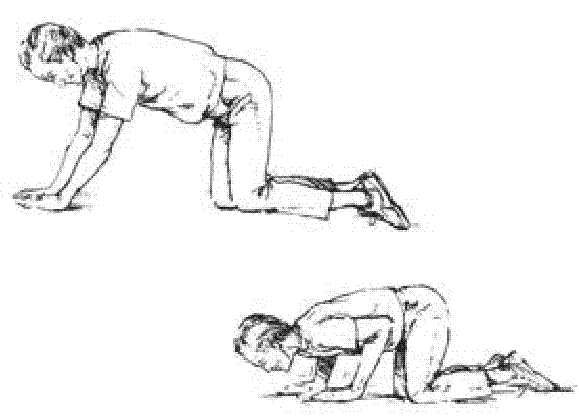
3) Modified Knee Push-up: to strengthen upper back, chest,
and back of arms. Start on bent knees, hands on floor and slightly
forward of shoulders. Lower body until chin touches floor. Return
to start. Suggested repetitions: 5–10.
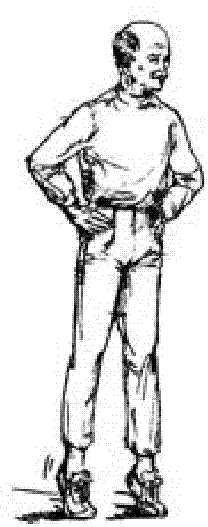
4) Calf Raise: to strengthen lower leg and ankle.
Stand erect, hands on hip or on back of chair for balance.
Spread fee 6" to 12". Slowly raise body up to toes, lifting
heels. Return to starting position. Breathe normally. Suggested
repetitions: 10-15
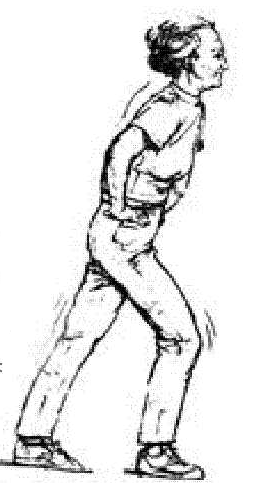
5) Alternate Leg Lunges: to strengthen
upper thighs and inside legs. Also stretches back of leg. Take
a comfortable stance with hands on hips. Step forward 18 to
24 with right leg. Keep left heel on floor. Shove off right
leg and resume standing position. Suggested repetitions: 5-10
each leg.
6) Modified Sit-up: to improve abdominal
strength. Lie on back, feet on the floor with finger tips
behind your ears. Look straight up at the ceiling and lift head
and shoulders off floor. Suggested repetitions: 10.
7) Side Lying Leg Lift: to strengthen
and tone outside of thigh and hip muscles. Lie on right
side, legs extended. Raise leg four to five inches. Lower to
starting position. Suggested repetitions: 10 on each side.
Strength: Level III
Note: In Level III strength exercise,
lightweight resistance equipment, such as the dumbbell, is introduced
to overload the muscles. While equipment of this kind is low
in cost and desirable, a number of substitutes can be used.
These include a bucket of soil, a heavy household item such
as an iron, a can of food, a stone, or a brick.
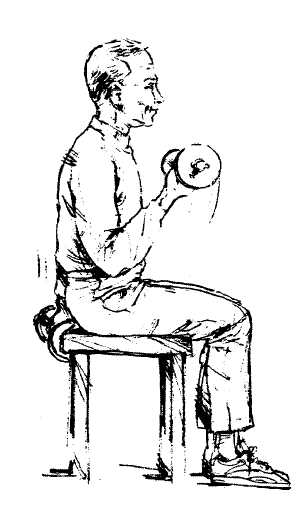
1) Seated Alternate Dumbbell Curls: to strengthen biceps
of upper arms. Sit comfortably on a flat bench with arms at
side. Hold a pair of dumbbells with an underhand grip, so that
palms face up. Bending left elbow, raise dumbbell until left
arm is fully flexed. Lower left dumbbell while raising right
dumbbell from the elbow until right arm is fully flexed. Breathe
normally. Suggested repetitions: 2 sets of 8 – 10 each arm.
(o)
2) Dumbbell Fly: to strengthen chest
muscles and improve lateral range of motion in shoulder girdle.
Lie on your back on a Flat bench or floor if bench is not
available. Grasp dumbbells in each hand over chest. Inhale and
lower dumbbell to side with elbow slightly bent. Raise
dumbbell in an arc to the starting position, exhaling in the
process. Suggested repetitions: 8 – 12.

3) Alternate Dumbbell Shrug: to strengthen muscles
in shoulders, upper back and neck. Stand comfortably with
dumbbells in each hand. Elevate shoulders as high as possible,
rolling them first backward and then down to the starting position.
Exhale as you lower the shoulders. Suggested repetitions: 10
forward, 5 backward. (o)
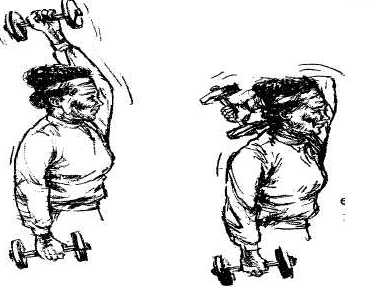
4) One Arm Dumbbell Extension: to strengthen triceps
(back of arm) and improve range of motion. Bring weight
up to shoulder and lift overhead. Slowly lower it behind the
back as far as is comfortable. Extend arm to original position.
Inhale on the way down, exhale on the way up. Suggested repetitions:
8 – 12 on each arm. (o)
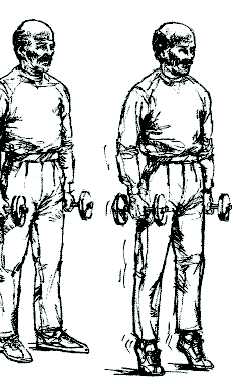
5) Dumbbell Calf Raise: to strengthen calf muscle and
improve range of motion of ankle joint. Stand with feet shoulder-width
apart, weights in each hand, toes on a 2" x 4" block (preferred
but not necessary). Raise up on toes lifting heels as high as
possible. Slowly lower heels to starting position. Breathe normally.
Suggested repetitions: 5 with heels straight back, 5 with heels
turned out, 5 with heels turned in.
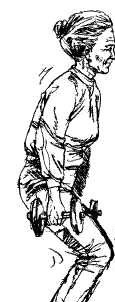
6) Dumbbell Half Squats: to strengthen thigh muscles
in front. Stand with feet shoulder-width apart and heels
on a 2" x 4" block (not necessary, but preferred). Holding weights
in each hand, slowly descend to a comfortable position where
the tops of the thighs are about at a 45 degree angle to the
floor. There is no benefit to a deeper squat. Inhale on the
way down. Stand up slowly, keeping knees slightly bent. Exhale
on the way up. Suggested repetitions: 10 -12.
7) Modified Sit-up: to improve abdominal
strength. Lie on back, feet on the floor, with finger tips
behind your ears. Look straight up at ceiling and lift head
and shoulders off floor. Suggested repetitions: 12-15.
Endurance
Endurance-building or aerobic exercises improve
the functions of the heart, lungs, and blood vessels. Vital
to fitness are a strong heart to pump blood to nourish billions
of body cells, healthy lungs where the gases of cell metabolism
are exchanged for oxygen and elastic blood vessels free of obstructions.
Without a healthy level of endurance, you may feel tired, lack
zest. You may also experience shortness of breath, rapid heartbeat
or even nausea.
Activities to improve endurance include brisk
walking, cycling, swimming, dancing and jogging. Walking is
actually one of the best all-round exercises. The massaging
action the leg muscles exert on the veins as you walk improves
the flow of blood back to the heart and also strengthens the
leg muscles.
Walking for Fitness
The following walking program has been designed
to help mid-life and older persons build and maintain cardiovascular
endurance. Walking offers several advantages over other forms
of exercise; it requires no previous instructions, it can be
done al- most anywhere, it can be done almost anytime, it costs
nothing, and it has the lowest rate of injury of any form of
exercise.
It takes a little longer to achieve conditioning
results through walking than through more strenuous activities,
but not much. One study showed, for example, that jogging a
mile in
8 1/2 minutes bums only 26 more calories than walking a mile
in 12 minutes. Conditioning benefits from walking improve dramatically
if you increase the pace to faster than 3 miles per hour (20-minute
mile). In another study, participants burned an average of 66
calories per mile walking 3 miles per hour, but 124 calories
per mile when they increased the pace to 5 miles per hour.
Choose a comfortable time of day to exercise,
not too soon after eating and when the air temperature is not
too high. Many people find it more enjoyable to exercise with
others. Follow the program at the recommended rate but be careful
not to overexert. Stop if you find yourself panting or feeling
nauseous, if your breathing does not return to normal within
ten minutes after exercising or if your sleeping is affected.
If you feel uncomfortable progressing at the recommended rate,
spend additional weeks at each level of exercise. For example,
if you reach a comfortable limit in the fifth week of the program
at 3 one-mile walks on alternate days, continue one-mile walks
but increase the frequency to 5,6,7 or more walks weekly until
you can move on to activity recommended for the sixth week.
How to Walk
A good walking workout is a matter of stepping
up your pace, increasing your distance and walking more often.
Here are some tips to help you get the most out of walking:
- Move at a steady clip, brisk enough to make
your heart beat faster and cause you to breathe more deeply.
- Hold your head erect, back straight and abdomen
flat. Toes should point straight ahead and arms swing at your
sides.
- Land on your heel and roll forward to drive
off the ball of your foot. Walking only on the ball of the
foot or walking flat-footed may cause soreness.
- Take long, easy strides, but don't strain.
When walking up hills rapidly, lean forward slightly.
- Breathe deeply, with your mouth open if that's
more comfortable.
What to Wear
Shoes that are comfortable, pro- vide good support
and don't cause blisters or calluses are the only spe- cial
equipment necessary. They should have arch supports and should
elevate the heel one-half to three-quarters of an inch above
the sole. They should also have uppers made of materials that
"breathe" such as leather or nylon mesh. Some examples are:
training models of run- ning shoes with thick soles, light trail
or hiking boots or casual shoes with thick rubber or crepe rubber
soles.
Wear lighter clothing than the temperature would
ordinarily dictate because brisk walking generates a lot of
body heat. In cold weather, wear several layers of light clothing.
They trap body heat and are easy to shed if you get too warm.
A woolen cap and mittens are important in very cold temperatures.
|

